The Historical Development of Fair Activities in Zagreb (guest appearance at the Zagreb Fair)
Zagreb City Museum and Zagreb Fair, exhibition on the occasion of the 70th anniversary of the Zagreb Fair
Exhibition concept: Ljubica Igić
Exhibition design: Ivan Ružić
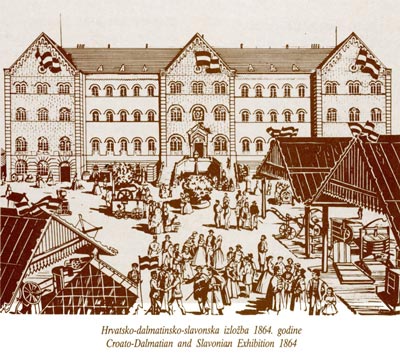 The selected artefacts of the exhibition testify the long tradition of international Zagreb fairs, which have been organized continually ever since the First International Economic Exhibition held in Zagreb in 1884.
The selected artefacts of the exhibition testify the long tradition of international Zagreb fairs, which have been organized continually ever since the First International Economic Exhibition held in Zagreb in 1884.
Before looking back at the great importance of the First Economic Exhibition (1864), it is worth saying that the oldest known big market of Zagreb, famous as a “royal market” is dated as early as the end of the 11th century, which is the time of the foundation of the Zagreb Diocese (1094). This market was held annually and always lasted two weeks: the week before and the week after the Day of St. Stephen the King (August 20). Six new markets were started in the later centuries thanks to the royal privileges. The most ancient and the most important among them was Marc's Fair which also lasted two weeks round St Marcus' Day. According to a 17th century piece of writing “numerous merchants from the East, mainly from Turkey, come to the fair, meeting there those from the West, mainly from Styria and Corniola. They come on rafts along the Sava River. Here they buy horses and wheat. After goods exchange they take mainland roads home.” Let us also say that these royal privileges proclaimed “God's peace” (tregua Dei) which should have been obeyed on market days. This means that all conflicts, thefts, rows, duals and similar things were prohibited. These were, of course, very important prerequisites for a success of the market and its business.
A gradual abolition of feudalism as well as a more and more powerful development of industry and modern traffic changed the very nature of these markets. Namely, progress saw a new kind of commercial publicity, such as specialized regional, national or international exhibitions.
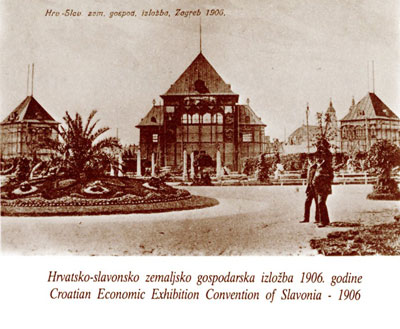 When the long-expected Zidani Most-Zagreb-Sisak railroad was finally opened, it created new possibilities for the economic development of Croatia. Moreover, the same year 34 Croatian exhibitors participated in the international exhibition in London, and it was them to have worked, together with the Zagreb Chamber of Commerce and Trade, on the organization of the First Zagreb Economic Exhibition. 3,886 exhibitors from all parts of Croatia as well as some from other countries of the Habsburg Monarchy, took part in the exhibition which was inaugurated on August 18, 1864 by Governor Josip Šokčević. All the branches of the economy of the time as well as science and art were presented at the exhibition. According to home and foreign newspapers it was a great success. Among other distinguished persons, Mr Hohenbruck and Mr H. W. Pabst, trade and agriculture ministers, visited the exhibition on behalf of the Vienna Ministry. In their report they praised both organizers and exhibitors. Many participants received awards at the end of the exhibition.
When the long-expected Zidani Most-Zagreb-Sisak railroad was finally opened, it created new possibilities for the economic development of Croatia. Moreover, the same year 34 Croatian exhibitors participated in the international exhibition in London, and it was them to have worked, together with the Zagreb Chamber of Commerce and Trade, on the organization of the First Zagreb Economic Exhibition. 3,886 exhibitors from all parts of Croatia as well as some from other countries of the Habsburg Monarchy, took part in the exhibition which was inaugurated on August 18, 1864 by Governor Josip Šokčević. All the branches of the economy of the time as well as science and art were presented at the exhibition. According to home and foreign newspapers it was a great success. Among other distinguished persons, Mr Hohenbruck and Mr H. W. Pabst, trade and agriculture ministers, visited the exhibition on behalf of the Vienna Ministry. In their report they praised both organizers and exhibitors. Many participants received awards at the end of the exhibition.
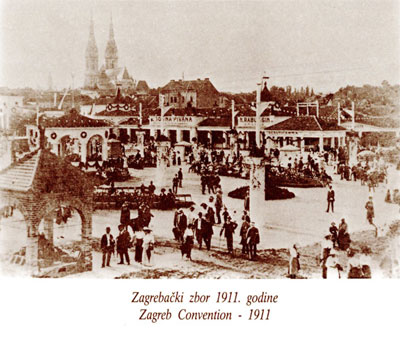 Another such exhibition was held in Zagreb in 1891 on occasion of the 50th anniversary of the Croatian-Slavonian Society. The next and the last jubilee exhibition was organized in Zagreb in 1906 by a group of distinguished Croatian businessmen and it was based on the experiences acquired at Central European exhibitions (Leipzig, Munich, Graz and others). As soon as 1909 they initiated the Zagreb Association whose purpose was to organize exhibitions and big fairs in order to contribute to a more intensive development of all industrial branches and economy in general as well as to increase the number of foreign visits to the city. The membership to the Association consisted of the founders and regular members, while all presidentional and representative seats were honorary. When the First Croatian Trade Bank granted the Association a 500-crown loan, they soon organized three large fairs. The first was held in 1910, the next in 1911 and 1913. The year 1912 was skipped because of the Balkan Wars. The first and the second exhibition was opened by Janko Grahor, President of the Zagreb Association, while his successor, Janko Radković, had a difficult task of saving what could be saved in the period after World War I when Yugoslavia was being created.
Another such exhibition was held in Zagreb in 1891 on occasion of the 50th anniversary of the Croatian-Slavonian Society. The next and the last jubilee exhibition was organized in Zagreb in 1906 by a group of distinguished Croatian businessmen and it was based on the experiences acquired at Central European exhibitions (Leipzig, Munich, Graz and others). As soon as 1909 they initiated the Zagreb Association whose purpose was to organize exhibitions and big fairs in order to contribute to a more intensive development of all industrial branches and economy in general as well as to increase the number of foreign visits to the city. The membership to the Association consisted of the founders and regular members, while all presidentional and representative seats were honorary. When the First Croatian Trade Bank granted the Association a 500-crown loan, they soon organized three large fairs. The first was held in 1910, the next in 1911 and 1913. The year 1912 was skipped because of the Balkan Wars. The first and the second exhibition was opened by Janko Grahor, President of the Zagreb Association, while his successor, Janko Radković, had a difficult task of saving what could be saved in the period after World War I when Yugoslavia was being created.
Following a two years' period of inactivity, the Zagreb Association comes to life again in 1921 when they were given a suitable piece of land in Martićeva Street for the period of 10 years. The construction of wooden pavilions was financed from the loans granted by the Zagreb banking institutions. The First Great International Fair of Specimen was held in 1922, 1923 and 1924. In 1925 Lujo Šafranek-Kavić became chairman of the Association and he held this position all the way through World War II. When the activities of the Zagreb Fair became more intensive, in 1925, apart from the general autumn fair, the Association opened other exhibitions such as a regular spring fair with a car show, fairs and exhibitions of folk artefacts, cattle, poultry farming, seeds, flowers, fruit and vegetables, wine, fashion and later telecommunications. In the meantime the Association also constructed five permanent pavilions. The main building had a large hall suitable for various purposes. Some 30 companies owned the big pavilions.
In 1925 the Zagreb Association joined the initiative of several leading international fairs to found the International Union of Fairs (UFI). The Association was, thus, one of its founders.
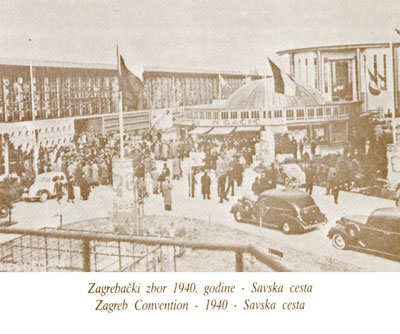 In 1936 they exchanged the piece of land in Martićeva Street for a place in Savska Street (presently Student's Dormitory). New pavilions were built in less than a year and a half and they soon had to be expanded. Four European countries held their pavilions permanently (Czech Republic, France, Italy, Germany) while numerous other countries participated from time to time with collective exhibitions (Belgium, Poland, Spain, the Netherlands, Greece, Finland, South-African Union and others). 600 foreign and domestic exhibitors took part in the 1939 fair.
In 1936 they exchanged the piece of land in Martićeva Street for a place in Savska Street (presently Student's Dormitory). New pavilions were built in less than a year and a half and they soon had to be expanded. Four European countries held their pavilions permanently (Czech Republic, France, Italy, Germany) while numerous other countries participated from time to time with collective exhibitions (Belgium, Poland, Spain, the Netherlands, Greece, Finland, South-African Union and others). 600 foreign and domestic exhibitors took part in the 1939 fair.
The tradition was continued after World War II (1945) under a new name – the Zagreb Fair.
The period after 1956 was especially important because, owing to the Mayor of Zagreb, Mr Većeslav Holjevac, the Fair was moved over the Sava. It marked the beginning of the vigorous growth of the Fair.
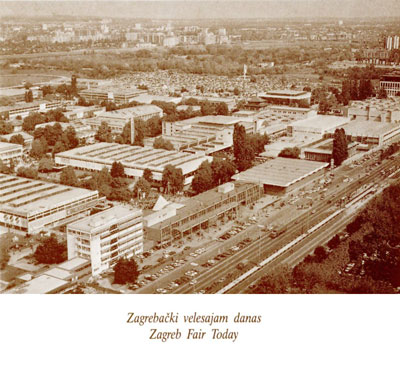 The Zagreb Fair is situated on 505,000 m2 of gross grounds out of which the indoor exhibition premises take more than 180,000 m2 whose modern infrastructure makes fair exhibitions also possible in winter time.
The Zagreb Fair is situated on 505,000 m2 of gross grounds out of which the indoor exhibition premises take more than 180,000 m2 whose modern infrastructure makes fair exhibitions also possible in winter time.
Every year the Zagreb Fair organizes more than 30 international specialized fairs which gather numerous home and foreign exhibitors and attract business attention of numerous visitors, experts and businessmen. The Zagreb International Autumn Fair is certainly one of the most important shows.
Before the Serbian aggression on the Republic of Croatia the Zagreb Fair hosted more than 6,000 exhibitors from fifty countries. However, thanks to the efforts of the employees of the Fair and the Croatian democratic authorities, the continuity of the Fair has not only been preserved, but renewed and intensified.
Apart from the exhibitions, numerous international congresses, conferences and symposia with distinguished names of world and domestic science, are also organized at the Zagreb Fair.
The Congress Centre of the Zagreb Fair consists of 22 equipped halls and offices of various size and purpose which can receive 2,200 people.
Modern conference, video, communication and other equipment is available for successful and high-quality presentation of scientific events. An experienced team of the Congress Centre experts offers a complete service of the organization: organization of accomodation and free time, publicity and advertising, simultaneous and consecutive translation, publication of anthologies and brochures, catering services, copying of programme and other handouts, and other services.
According to the new development programme of the Zagreb Fair, starting from 1994, a part of the indoor exhibition space has been turned into a permanent exhibition of Croatian economic potentials – Trade Market. In this way foreign visitors would be able to see in one place all the Croatian products for export.
Since 1990 World Trade Centre (WTC), an association of New York WTC – a distinguished family of 260 centres from 69 countries – has been present on the Zagreb Fair, establishing in this way the best communication with world economy.
Agneza Szabo, PhD

